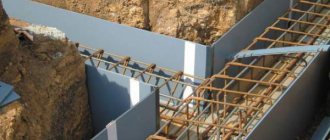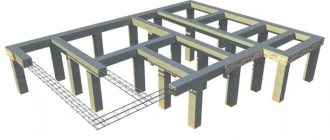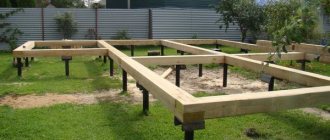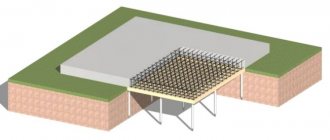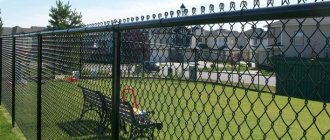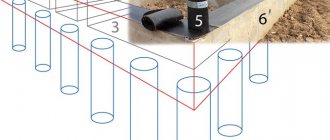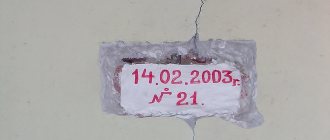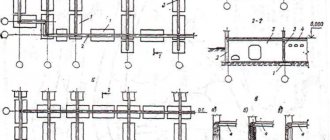The pile-screw foundation is the only one that can be installed regardless of the season and weather conditions. So, for example, pouring a strip base in winter is associated with difficulties in preparing the soil and difficulty in hardening the solution due to the presence of water in it. At the same time, installation of screw piles in winter can be done with less labor and high quality of support formation.
Important: when constructing a pile-screw foundation in the cold season (frost), it is necessary to adhere to a certain technology. Deviation from certain rules threatens injury to the master and a discrepancy between the strength and reliability of the foundation according to the standards.
The harmful role of negative temperatures in construction
Of course, winter is not the best time for construction, especially individual construction:
- Most work is carried out outdoors
- There are difficulties in using any tool
- Access to the equipment site is difficult due to snowdrifts
- Additional heating costs increase
- A mandatory temporary hut for workers is required
- The sunny day is short
In addition, any building material changes its properties precisely at negative temperatures. If we look at reference books and operating instructions, we will see that the temperature of storage and work should often be within 10-25 degrees Celsius. This applies to concrete, paint and varnish products, various coatings, etc.
The desire to overcome the fundamental disadvantages of winter construction leads to increased costs compared to summer:
- For heating
- For additional lighting
- To accommodate the brigade
- Purchase of “frost-resistant” equipment and materials
Construction in winter is a big hassle
Why is it profitable to build in winter?
However, be that as it may, construction in winter also has some positive properties:
- Relatively cheaper construction. This applies to both materials and wages for builders.
- The overall construction time does not increase due to winter downtime, which is especially important when you urgently need to change your place of residence
- Some of the main work is carried out in winter, and finishing begins in summer.
- It is better to move into a house in the spring, when during the warm season there is an opportunity to eliminate any deficiencies
Well, and besides, there are also everyday advantages that you can take with a smile:
- No heat
- No mosquitoes
- Lack of rain, which can permanently stop any construction
Moreover, in some cases, winter construction even looks preferable - for example, when laying a foundation in swampy areas or on reservoirs, which will be discussed in more detail below. In addition, it is along the “winter road” that it is possible to get to other wildernesses - for example, to the same swampy areas. This applies mainly to industrial construction, but is also typical for other private landholdings.
Pile drilling rig
Laying a traditional foundation in winter and its existing limitations
As for the construction of the foundation of houses - the foundation, the winter period is practically forbidden for them. The main reason is the properties of concrete, and reinforced concrete foundations have been the most common in individual construction for a long time.
The mortar is mixed, as you know, with water. At temperatures below zero, water hardens, as a result, even if the solution can be mixed with water from a well or borehole, its hardening does not occur at all according to the instructions. The cement particles do not set and complete hardening does not occur. In the worst case, the frozen mixture will simply crumble, in the best, the properties of the resulting concrete will be far from those designed to support the weight of the building.
Builders, of course, stubbornly struggle with negative temperatures when laying foundations - science is constantly developing new additives that eliminate the harmful effects of freezing water, engineers are developing methods for heating the solution, etc. and so on. But there is only one conclusion: it is better not to lay concrete foundations in winter.
Thus, construction will begin, at best, no earlier than March, or even April. And taking into account the total period of construction of the foundation and complete hardening of the concrete, just laying the foundation will take at least 40-45 days. In some areas, this is just half of the full construction season. In ordinary ones - a third. It is unlikely that in the remaining time it will be possible to completely build the frame of the house, especially a brick one.
This is how construction drags on for years.
Insulating a concrete foundation is very expensive
Advantages of a pile-screw foundation in winter construction
All difficulties associated with laying a foundation in winter are successfully solved using screw pile technology:
- Installation of piles lasts on average 1-2 days, during daylight hours, and, if necessary, under artificial lighting
- There is no need to clear the area of snow
- On reservoirs, thick ice cover makes it possible to remove heavy equipment
- The absence of concrete work allows you to immediately build a building on an established foundation
- The absence of mass orders during the off-season reduces the cost of work, making it easier to find a free team
- Well, traditional ones - it’s not so hot, insects don’t bother you, and it’s not pouring rain.
Thus, laying a pile-screw foundation allows construction to begin at almost any time of the year. If you plan to build a log or frame house, where “wet” work is also not planned, then the construction of the box can be completed in one to two months. Many developers successfully use this and begin finishing work in early spring, and you can move into the house in early summer.
Automation is also possible in winter
Cost of work
Each pile will cost approximately 14-120 USD. for one pile, and the price will depend on the length and cross-section of the pile
If you are interested in how much it will cost to install a pile-screw foundation, then you need to understand that the prices for piles do not differ from summer prices. Each pile will cost approximately 14-120 USD. for one pile. Moreover, the price will depend on the length and cross-section of the pile. The price of the anti-freeze additive will be added to the cost amount. Its cost varies between 0.8-1.6 USD. for one liter. For 100 kg of dry cement, approximately 4-5 liters of additive are used.
Important: construction and installation companies are interested in clients during the winter period, since the demand for services at this time is low. Therefore, there is a chance to slightly reduce the price of the work.
Features of installing screw piles in winter
We talked about the undoubted advantages of installing a foundation on screw piles in winter, but, of course, low temperatures and winter conditions make installation of piles more difficult than in summer:
- The foundation area is most often covered with snow. This does not mean that it needs to be completely cleared out with a bulldozer, as when installing monolithic reinforced concrete foundations. However, snow cover makes it difficult to assess elevation changes in the area. Of course, the developer usually manages to determine the slope of the site even in warm weather, but there are cases when the purchase of land and construction begin in the winter
- Drilling frozen ground is much more difficult than drilling soil at above-zero temperatures
- Filling piles with concrete after trimming cannot be carried out as usual, because, as we said above, the water solution loses its optimal properties
- Working with icy, frozen piles is dangerous due to the likelihood of frostbite on your hands
- The metal itself from which the piles are made becomes much more fragile than at positive temperatures; this can cause breakage of the blades when screwed in and requires additional caution. Shocks, excessive vibrations, etc. should be avoided.
- Equipment also does not always withstand low negative temperatures.
- Manual installation is difficult due to the excessive density of the soil, and is often impossible
- Frozen soil does not allow us to evaluate the difference in the wrapping force between the top layer and the dense bottom layer - below the soil freezing level.
- It is difficult to carry out high-quality geological surveys to determine the soil characteristics of the site if this was not done in the summer.
- Test wrapping, usually done manually, is difficult
- And, of course, working outdoors in severe frosts is not very comfortable
But of course, all these difficulties cannot be compared with the difficulties and unnecessary costs of laying traditional reinforced concrete foundations.
You need to work carefully in cold weather
Technology and principles of work execution
When screwing in support pillars, the most difficult section is 1.5-2 meters of soil
In order for the foundation on screw piles to be installed correctly in winter and have the optimal load-bearing capacity for construction, it is advisable to carry out all design work in the summer. It is during this period that it is possible to fully analyze the properties of the soil on the site, and therefore calculate its behavior in contact with the piles. In addition, it is in the warm season that it is advisable to make markings for support pillars. Since in winter it is more difficult to lay out the foundation axes due to the snow crust.
Important: if it was not possible to do the marking in the summer, then it can be done in the winter. The main thing for this is to clear the area of snow. But don’t be too zealous, since snow is a natural heat insulator that reduces the depth of soil freezing.
Otherwise, the technology for screwing in piles will look like this:
- First of all, screw the supports. Due to the fact that the ground is frozen, screw piles will be very difficult to screw in, and therefore it is not recommended to do the work manually. It is better to use a motor drill for soil development. But it is worth remembering that it is first advisable to warm the ground with fires at the site where the support is installed. This process is quite long and labor-intensive, but it will prevent damage to the metal of the pile or drilling rig. And as a preliminary preparation of the ground for drilling, you can make special pits - sample the soil to the level of its freezing. When performing this installation stage, you should remember safety precautions and work only in protective gloves to avoid frostbite or thermal burns.
Important: when screwing in support pillars, the most difficult section is 1.5-2 meters of soil. After passing this mark, drilling will be easier, comparable to drilling in the warm season.
- After the screw piles are installed in the intended places, it is necessary to fill the voids of the pile with concrete mixture. This is necessary so that the pipe does not deform during seasonal changes in the soil (freezing/freezing). Otherwise, the support will not have its load-bearing capacity.
Important: pouring the solution at sub-zero temperatures can cause difficulties, since the main binding component, water, can crystallize. And this interferes with the quality of the solution’s hardening. The problem can be solved.
Phased construction of a pile-screw foundation in winter
In general, the process of laying a pile-screw foundation does not depend too much on the time of year. Let us highlight its main stages, taking into account negative temperatures:
- Test screwing (as noted above, it is difficult and can only be done with a pile drill)
- Planning the foundation relative to its load-bearing capacity
- Preparation of the site, and there is no need to completely remove the snow
- Marking the area, taking into account possible snowdrifts
- Installation of screw piles, in this case in frozen dense soil
- Removing the general plane of the foundation by cutting piles is practically independent of the season. Difficulties may arise with caution when using an angle grinder in severe frost.
- Concreting piles, in which ordinary mortar cannot be used
- Installation (if necessary) of caps for grillage
Let's consider how we can neutralize the harmful effects of negative temperatures on the conduct of one or another stage
Winter version of the foundation
Features, pros and cons of a pile-screw foundation
This type of foundation is a set of piles that are screwed into the ground. You can do this yourself or use special equipment. A grillage is made on top - tying screw piles, which are located separately, into a solid structure. It can be made of wood or metal.
Foundation with metal grillage
What are piles
Each pile looks like a metal pipe with thick walls - from 40 to 120 mm . It has a blade-shaped tip with a large thread, which helps to screw the piles into the ground and at the same time serves as a support for the ground. The diameter of the blades varies - from 20 to 85 cm .
2-2.5 m are most often used . Thanks to the ideal shape of the blades, they can be easily screwed in to the required depth with the efforts of 3-4 workers.
Screw piles
Attention! If there are differences in height or there is another lateral load, piles with two blades . Due to this, the foundation and the building standing on it become even more stable.
Piles can be hollow or solid. For foundations, hollow ones are most often used so that concrete can be poured into the middle. The blades of the pile are located perpendicularly, so the screw will not loosen the soil. Their load-bearing capacity is in the range of 5-25 tons . When building a foundation, you can choose from several project options. The choice will be influenced by the type of soil and the architectural features of the building .
Table 1. Foundation projects.
| What does it look like | When to use |
| Single piles | Serve to support individual elements. Often used when you need to add something to a finished building |
| Standard foundation | Suitable for columns, the main elements of the building |
| Pile tapes | Located under the walls of the house |
| Pile field | Used in the construction of heavy structures |
The protective coating of piles requires special attention. The most reliable building materials are made with polyurethane resin spraying and galvanized piles. The latter are obtained by hot-dip galvanizing. They have a protective coating on both the inside and outside.
Interesting to know! To check the quality of the piles, you can ask a building materials store to do a test twisting. If the metal is heavily exposed, the protection will be poor, but if the coating is reliable, it will remain undamaged.
Advantages of a pile-screw foundation
If you choose high-quality building materials, the foundation built from them will have the following advantages:
- Piles can be reused if they are carefully removed without leaving damage to the protective coating.
- There is no need to carry out a large amount of construction work. Moreover, installation of this type of foundation is possible even on moving and watery soil.
- You can begin building the house immediately after installing the head.
- The service life of a foundation on piles is from 150 years. If you provide them with additional protection against corrosion, they will last another 50 years more.
- The price of a pile-screw base is 3 times less than that of a strip base.
- Upon completion of work, no construction waste accumulates on the site.
Installing such a foundation takes from 1 to 3 days , if you do everything manually, without the use of technical means.
Do-it-yourself installation of screw piles
Design flaws
Its few disadvantages include the following:
- Not suitable for installation on coarse or rocky soil types.
- If the installation technology is violated, the foundation will deform over time. This will happen if you do not fix the position of the piles and do not tie them properly.
- If the protective coating is of poor quality, the piles will be susceptible to corrosion, and this will have a negative impact on the stability of the structure in the future.
To avoid these shortcomings, it is recommended to examine the soil on the site in advance, choose high-quality materials and follow the recommendations for installing piles.
Support covered with rust
Installation of screw piles in winter
You can drive the piles in an area where the snow has not been completely cleared - the main thing is that there is access for equipment. Snow cover protects the soil from deep freezing, and the area near the place where the pile will be screwed will be trampled by workers one way or another. Of course, if there are meter-long snowdrifts, you will have to work with a shovel in such places.
As a rule, the depth to drive a pile in winter has to be determined in advance, focusing mainly on the average thickness of soil freezing in a given area. It should be taken into account that frozen soil is much harder than warmed soil, which makes it difficult to begin the process in the first place. The pits that are recommended to be dug will be difficult to do manually, and you will have to use a hole drill.
In general, a hole drill can easily cope with a frozen layer of soil, because screw piles are successfully installed even in permafrost areas.
Let us remind you that all work must be carried out very carefully and accurately - it is important not to suffer injuries associated with the highly cooled surface of the metal (especially when controlling the verticality of screwing), as well as with the fragility of the piles themselves, especially the blades and welded joints.
Note that winter is perhaps the only season when it is possible to successfully install piles for walkways, piers, and similar structures on the water. Stable ice in the middle of winter can easily withstand the heaviest equipment used in the installation of screw piles. More details about this can be found in the corresponding article on our website.
Under the ice, the soil can be turned by hand
Finally, how is the issue of concreting piles resolved in winter? It is not recommended to pour regular concrete mixture. The point is not only that concrete loses its properties at low temperatures. Frozen water increases in volume, turning into ice, and can simply rupture the pipe body, which, of course, is unacceptable.
Technologists sometimes advise the use of various additives that facilitate the hardening of concrete at low temperatures, and they are used in the construction of reinforced concrete foundations, but in the case of screw piles it is better not to take risks.
The most optimal way is to backfill the screw pile with a special dry concrete mixture, which hardens by selecting sufficient moisture from the surrounding air. Such mixtures are now successful and widespread.
How to insulate a pile structure?
Let's consider the algorithm for insulating the base of a pile-screw foundation.
Frame installation
There is no need to be clever here. The pipes are laid horizontally, for which you need to use a building level. There are no strict standards for the location of frame elements relative to the frame of the house and the ground.
Optimal - 5 cm . That is, the pipe will not touch the ground, which will increase its service life due to the absence of metal corrosion.
It is better to weld the profile pipe to the screw piles. Some people try to fasten them with self-tapping screws, others with clamps. In this case, a more reliable method than welding cannot be found.
Laying insulation
As mentioned above, there are two options for laying insulation:
- From the outside.
- From the inside from the side of the organized basement.
Option #1
For this purpose, more durable polystyrene foam is used. The slabs are simply laid on the frame and secured to it with self-tapping screws with press washers or simply wide washers. For example, like in the photo below.
The distance between fasteners is 20-30 cm . Self-tapping screws in length are selected taking into account the thickness of the insulation, the wall thickness of the profile pipe, plus 5-10 mm.
There is no need to screw in fasteners much. That is, there is no need to embed the washers into the plate. The main task here is to fix the thermal insulation material. And since there are a lot of screws, the quality of fastening will be high.
It is recommended to choose slabs with a tongue-and-groove connection . When laying on the surface of the heat-insulating layer, there are no gaps or cracks.
If ordinary slabs with smooth edges were purchased, then they try to lay them in such a way that there are no gaps between them. If any are formed, they are filled with polystyrene foam or a special sealant for polystyrene boards. It is very similar to foam, but does not expand in volume when exposed to air.
Video instructions for insulating the base of a pile-screw foundation:
There is another option . To do this, a flat material is first installed and secured to the frame. For example, an OSB board or flat cement-asbestos slate can be used. And the insulation is already attached to it either with self-tapping screws or with an adhesive composition for polystyrene foam boards. The latter is sold in cans. The fastening is reliable.
Option No. 2
The situation is that facing material is installed on the outside of the mounted frame. There is a huge variety of options offered, for example, corrugated sheeting. Since the base becomes decorated, the insulation process is transferred inside, that is, under the house. This often happens when thermal insulation was not part of the home owner's original plans.
After living one winter in such a house, even with insulated floors, many decide to insulate the foundation. You can also use Penoplex for this.
The process is carried out according to the following scheme:
- mineral wool mats are cut to the required dimensions for the height of the foundation base;
- trimming is done so that the material fits tightly between the frame of the house and the ground;
- Fastening to the frame is carried out in exactly the same way as in the previous version: with self-tapping screws and wide washers.
Here it is again important not to leave gaps between the insulation boards, which turn into cold bridges.
Option #3
It is based on the use of the most effective thermal insulation material - polyurethane foam . This is foam that is applied under pressure to the surface to be insulated. In air it polymerizes, becomes strong and monolithic, that is, without a single crack.
This insulation is applied only from inside the premises. For this, professional equipment is used. That is, we are not talking about carrying out the work independently. The thermal insulation layer can be applied to any surface; it has maximum adhesion properties. Polyurethane foam itself is an expensive material, plus the cost of work. But the insulation efficiency is the highest.
It is precisely because of the high cost that pile-screw foundations are not insulated with polyurethane foam. It will be cheaper to use mineral wool, plus insulate the floors.

